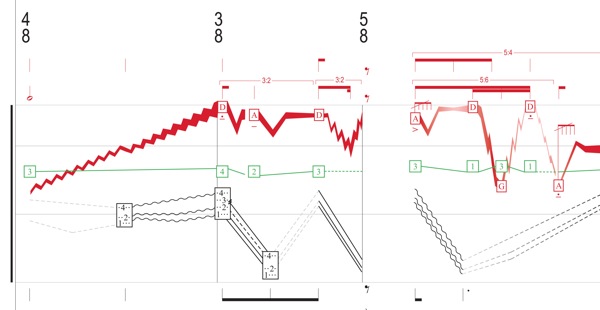The first two days of the 2010 Donaueschinger Musiktage got me thinking more and more about two related words, and how they play out: transparency and risk. Another way to put it might be the turning what is inward, outward. A number of these pieces scatter along an amorphous continuum of transparency, exposure, vulnerability, risk, danger.
In Liza Lim‘s, The Guest, the orchestra’s material seemed to point inward, not just to the solo material, but to the inner workings of the recorders themselves. A vast constellation of orchestral sound circled around the recorder, and the dynamic flow of breath, liquid, energy, within it. It’s natural to associate a compelling presence with instruments capable of producing more sound. But Lim and Jeremias Schwartzer revealed a complex and delicate intensity that was absolutely riveting. The orchestra neither supported nor protected the recorder, but seemed to observe and react as sonic spectators.
Aaron Cassidy‘s 2. String Quartet is notated in such a way that it overlays each player’s physical motions onto a staff that represents the instrument in one continuous space. A score excerpt will be helpful here:

The four staff lines are, from top to bottom: bridge, end of fingerboard, top of instrument body, and nut. The shade and thickness of the red line indicates bow pressure, and its placement on the staff shows the point of contact between the bow and the instrument. The left hand notation, in black, follows a similar pattern, also indicating location, finger pressure and, in the case of the wavy lines, vibrato. Bow speed, direction, and region are shown in green. I heard and saw this transparency of motion in the JACK quartet‘s performance. There is an unobstructed flow from score to motion to sound. The JACK quartet read the score fluently and fluidly, bringing out the dynamic phrasing of the work and the currents that lead into and away from a shared body of sound and energy. The entire piece has a luminous, unencumbered quality, and a rich interplay of these streams of activity.
In Alan Hilario‘s slap Schlag, Klaps + stick Stock, the types of action that apply to string instruments are repeatedly and extensively divorced from the instruments themselves, and foregrounded as percussive actions. There was an immense, explosive energy in the JACK quartet’s performance, that went along with a high degree of precision. It referenced slapstick, not just in the title but in some of the actions that you can see in the video below, like the rhythmic air punches between the players. I had a feeling almost throughout the percussive sections of the piece of, “this could be funny, but I find myself taking it quite seriously.” The phrase “benign brutality” seemed to fit with the experience, though it makes no sense in itself. It may have something to do with its combined length and intensity. The whole percussion setup could have seemed like a stunt, but it was done (both by Hilario and by the JACK quartet) with such commitment and intensity that it seemed like a genuine extension of the quartet dynamic. When they did use their instruments, they carried on the gestures of the opening, the rhythms, and the percussiveness. One action that seemed quite representative was an abrupt, muted strumming. The damping of the strings was one of many limitations that demanded maximized effort towards sound production without maximizing the volume. I heard that motion, as well as the abrupt bows and scrubbing sounds, as frustrated effort—very similar to the work the players had to do away from their instruments for so much of the piece, going to similar gestural efforts without being in their instrumental home territory. Near or at the end of the piece, pitch forks brought the percussion-centered and string-centered aspects of the piece together, by first hitting the forks and then using the instruments to make them resonate. It took a tremendous effort and commitment to make the string/percussion integration convincing. It was. You can see a brief excerpt near the beginning of this NMZ broadcast:
The performative situation was turned inside out in yet another way in Peter Ablinger‘s Wachstum und Massenmord. At the start of the first performance, the players had not yet opened the score, and they were to rehearse a portion of it onstage. The rehearsal process is inherent to performance. It drives it and determines it significantly. But it is normally hidden, protected. In this case—on a day that was centered around the phenomenon of the string quartet—it was not. We never heard Ablinger’s “piece,” if by that is meant a front-to-back performance of the score. We heard how the quartets (JACK and Diotima) went about rehearsing the piece. Well, even that’s not completely true. I’ll write another post about how the performances played out and the tangled web of issues, thoughts, and provocations that emerged.
